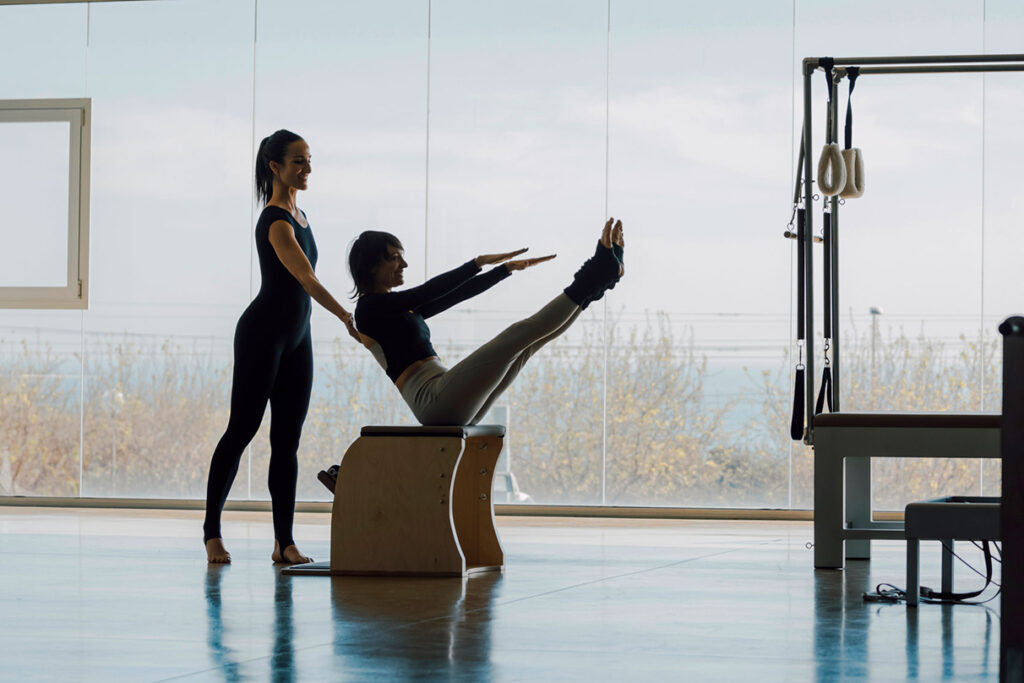Have you ever noticed the increasing number of Pilates studios in your area and wondered what’s fueling their growth? You’re not alone. The secret’s out: Pilates is not just a fitness craze; it’s a booming industry with a bright financial future. With the Pilates market on track to expand to an impressive $409 billion by 2032 the allure of starting a Pilates studio is stronger than ever. This guide is your first step towards tapping into this market, offering a blend of practical advice, industry insights, and actionable strategies to turn your Pilates passion into a profitable business.
Whether you’re a Pilates enthusiast looking to share your passion with the world, or an entrepreneur searching for your next venture, the path to opening a Pilates studio can be as rewarding as it is challenging. This comprehensive guide will walk you through every step of the journey, from initial concept to opening day and beyond. We’re here to demystify the process, providing you with the tools and knowledge you need to launch a successful Pilates studio that stands out in a crowded market.
Ready to lay a strong foundation for your studio? Mariana Tek’s Pilates Studio Software can help you manage operations seamlessly, from class scheduling to client communications.

Why Open a Pilates Studio?
Opening a Pilates studio presents a unique opportunity in a world where wellness and fitness are not just trends but lifestyles. But what makes Pilates stand out in the crowded fitness market? Let’s dive in.
A Growing Demand: The numbers don’t lie. Pilates has seen a surge in popularity, not just as a form of exercise, but as a holistic approach to health and wellness. This growing demand is a clear signal that the market for Pilates is not just present but expanding. With more people looking to improve their physical strength, flexibility, and mental well-being, Pilates studios are becoming a sought-after destination.
The Benefits for Owners and Clients: For studio owners, Pilates offers a business model with considerable potential for profitability and client retention. Pilates clients are often loyal, committed, and willing to invest in their health, providing a stable customer base. For clients, the benefits of Pilates include improved posture, muscle tone, and stress reduction, among others. This mutual benefit creates a strong foundation for a successful business.
A Community of Wellness: Opening a Pilates studio goes beyond financial gains; it’s about building a community. Your studio will become a sanctuary where people come to work on their physical and mental well-being. It’s a place where lasting relationships are formed, not just between instructors and clients, but among clients themselves. This sense of community can become one of your studio’s most significant selling points.
Flexibility and Creativity: As a Pilates studio owner, you have the freedom to shape your business. Whether you focus on traditional Pilates, incorporate contemporary methods, or specialize in rehabilitation, your studio can reflect your vision and expertise. This flexibility allows for creativity in your offerings, making your studio stand out in a competitive market.
A Fulfilling Venture: Lastly, opening a Pilates studio is incredibly fulfilling. Watching clients achieve their health and fitness goals, knowing you’re contributing positively to their lives, brings a sense of satisfaction that’s hard to find in other businesses. It’s not just about making a living; it’s about making a difference.
In the next sections, we’ll cover the practical steps to turn this opportunity into reality, ensuring your Pilates studio not only opens its doors but thrives in the long term.

Laying the Foundation
Develop Your Business Plan
A successful Pilates studio begins with a blueprint for the future – your business plan. This crucial document outlines your vision, maps out financial projections, and provides a roadmap to achieve your goals. Don’t be intimidated; even a simple plan is better than none! Here’s what to include:
- Executive Summary: Briefly summarize your studio concept, target market, and competitive advantages.
- Market Analysis: Research the fitness landscape in your area. Who are your competitors, and what’s the demand for Pilates like?
- Competitive Research: Dive deeper into other Pilates studios. What are their strengths, weaknesses, and pricing structures?
- Marketing Strategy: Plan how you’ll attract clients and stand out in the market.
- Financial Projections: Estimate start-up costs, ongoing expenses, and revenue projections for the first few years.
Obtain Essential Certifications
Becoming a Pilates instructor requires more than a passion for the modality, but dedicated training and certification. To ensure you provide clients with safe and effective instruction, you’ll need to choose a reputable certification program. There are different certifying bodies, so research their requirements, costs, and reputation within the industry.
Here are a few things to look for in a certification program:
- Accreditation: Choose a program accredited by a respected organization in the Pilates industry.
- Comprehensive Curriculum: The program should cover anatomy, movement principles, Pilates exercises, and teaching techniques.
- Experience: Ensure the program includes hands-on practice teaching hours.
Building Your Studio
Find the Perfect Location
Your studio’s location plays a vital role in its success. Consider the following when choosing a spot:
- Demographics and Target Audience: Where does your ideal client live and work? Choose a location convenient for them.
- Accessibility and Visibility: Is it easily reached by car or public transportation? Is there ample parking? Does it have good street visibility?
- Parking and Foot Traffic: Make sure there’s convenient parking and consider foot traffic to attract walk-in interest.
- Size and Suitability: Ensure the space is large enough for your equipment and the type of classes you plan to offer. Check for adequate ventilation and lighting.
Secure Funding
Opening a Pilates studio requires an investment. Here are some ways to secure the necessary funds:
- Personal Savings: Tapping into your savings offers flexibility, but consider whether it’s a sound financial risk for you.
- Business Loans: Explore your options with banks and other financial institutions specializing in small business loans.
- Crowdfunding: Platforms like Kickstarter or GoFundMe can help generate funding and build early community support.
- Specialized Studio Financing: Solutions like Xplor Capital offer tailored financing specifically for fitness studios. This can simplify the financing process and provide access to capital designed for your business needs.
Hire the Right Team
Your team is the foundation of your Pilates studio’s success. Here’s what to look for as you build your staff:
- Qualified Pilates Instructors: Seek instructors with recognized certifications, technical expertise, and a passion for teaching and connecting with clients.
- Front Desk Staff (optional): Consider a friendly receptionist to greet clients, handle bookings, and manage administrative tasks.
- Cleaners (optional): Hire cleaners to maintain a hygienic and inviting studio environment.
Building a great team takes thought and strategy – for a deeper dive into the hiring process, check out our blog on The Fitness Studio Hiring Guide: Building a Team Clients Love.
Establish Operational Procedures
Streamlining your operations ensures a smooth experience for both you and your clients. Consider these key elements:
- Class Scheduling: Decide on your class schedule and develop an efficient booking system (Mariana Tek’s software can play a key role here!).
- Booking and Payment Systems: Choose a reliable system for managing appointments, payments, and client information.
- Client Management and Communication: Establish clear procedures for client intake, communication channels, and retention strategies.

Marketing and Branding
Define Your Brand
Your Pilates studio’s brand is its personality, what sets it apart from the competition. Take time to develop a unique identity and a consistent voice.
- Mission and Values: What are you passionate about? What kind of experience do you want to create for clients?
- Visual Style: Design a logo, choose color palettes, and select a visual aesthetic that reflects your brand.
Build an Online Presence
In today’s digital world, a strong online presence is essential.
- Website: Create a professional website that showcases your services, pricing, class schedule, and instructor biographies. Optimize for search engines (SEO) to enhance visibility.
- Social Media: Actively engage on platforms like Facebook, Instagram, or TikTok to connect with potential clients, share updates, and showcase your studio’s community.
Launch Targeted Marketing Campaigns
Reach your ideal clientele with these strategies:
- Introductory Offers: Attract new clients with free trial classes, discounted packages, or referral incentives.
- Partner with Local Businesses: Collaborate with complementary businesses (e.g., a physical therapy clinic, healthy cafes) for cross-promotion.
- Email Marketing: Stay connected with your clients by sending newsletters, promotions, and studio updates.
For even more inspiration and a ready-to-use social media calendar, check out our blog 2024 Fitness Marketing Guide+ Free Social Media Calendar.
Ongoing Success
Foster a Strong Community
A Pilates studio isn’t just a place to work out; it’s a place where people connect and feel supported. Here’s how to cultivate a thriving community:
- Organize Social Events: Host workshops, client appreciation events, or challenges to foster a sense of belonging.
- Encourage Feedback: Actively solicit client feedback to show you care about their experience and strive for improvement.
- Celebrate Client Milestones: Recognize client achievements and loyalty to make them feel valued.
Stay Current with Industry Trends
The fitness industry is dynamic. Show your commitment to continuous improvement by:
- Continuing Education: Encourage your instructors to pursue additional certifications and workshops to expand their knowledge.
- Adapt to Trends: Consider incorporating new variations of Pilates or complementary fitness classes to keep your offerings fresh and appealing.

FAQ: Your Pilates Studio Questions Answered
Q: How much does it cost to open a Pilates studio?
A: The cost of opening a Pilates studio can vary significantly depending on factors like location, studio size, equipment, and marketing. On average, you can expect to invest anywhere between $50,000 to $100,000, but costs might be lower or higher depending on your specific circumstances.
Q: Do I need special certifications to open a Pilates studio?
A: While not always legally required, a reputable Pilates instructor certification is highly recommended to ensure you provide safe and effective instruction. It also establishes your credibility for attracting clients. Research different certification programs in your area to find the best fit.
Q: What’s the best location for a Pilates studio?
A: Look for a location with good visibility, convenient access, and ample parking. Consider your target demographic – where do your ideal clients live and work? It’s also important to ensure the space is suitable for the size and type of classes you plan to offer.
Q: How do I find qualified Pilates instructors?
A: Start by networking within the Pilates community. Post job openings on fitness-related job boards and consider partnering with Pilates certification programs that may have recent graduates seeking positions. Focus on finding instructors who are passionate, certified, and align with your studio’s values.
Q: How can I make my Pilates studio stand out in a competitive market?
A: Focus on creating a unique brand identity, offering excellent customer service, and fostering a strong community atmosphere. Consider specializing in a niche area of Pilates or providing diverse class options to differentiate yourself.
Q: What type of equipment do I need for a Pilates studio?
A: Essential Pilates equipment includes Reformers, mats, Wunda chairs, Cadillac, and various smaller props. The quantity of equipment will depend on class size and your studio’s capacity.
Q: What kind of software do I need to run my Pilates studio?
A: Specialized Pilates studio management software can significantly streamline your operations. Look for a platform that handles class scheduling, client management, payments, and reporting. Mariana Tek’s Pilates Studio Software is designed to meet these needs and more.
Final Thoughts: Your Pilates Journey Starts Here
Opening a Pilates studio is an exhilarating journey. Embrace the challenges, celebrate the victories, and never lose sight of your passion. The right tools can streamline the journey, letting you focus on what matters most – sharing your love of Pilates. Want to simplify your studio management? Book a demo to explore how Mariana Tek’s Pilates Studio Software can support your vision.

by Julie Sippy Senior Marketing Manager, Brand & Community
-
First published: March 21 2024
Written by: Julie Sippy
